In my last blog post I took you on a tour of the awesome Tasmanian Devil Unzoo, and this week I am continuing the theme with a post all about my exciting visit to the Bonorong Wildlife Sanctuary! Located about a half hour’s drive from the CBD of Hobart, Bonorong is one of the most well-known places to go and see Tasmanian animals and I have some great memories of visiting when I was a child with family.
*I was a guest of Bonorong Wildlife Sanctuary for this visit, but all thoughts and opinions are my own and I would absolutely recommend this place to anyone visiting Tasmania and looking to meet some native wildlife!
Affiliate Links
This post contains affiliate links. This means that if you follow a link and then purchase or book something, I will earn a small commission at no extra charge to you. This helps me with the costs incurred from running this site and means I can keep bringing you travel content like this. You can read more about this on my privacy page. Thanks for your support!
What is Bonorong?
Bonorong Wildlife Sanctuary is (obviously) a sanctuary for wildlife. But it’s more than just a place where you can go to see animals in enclosures as they are not a zoo and aim to get all of their rescued animals back into the wild if possible. They operate Tasmania’s largest 24-hour rescue service for injured wildlife and whenever possible work to rehabilitate rescued animals back into the wild. Some of the animals on exhibit are permanent residents due to being unable to survive in the wild any longer, but many are only there until they are old or healthy enough to be re-released into the Tasmanian bush.
What do they do?
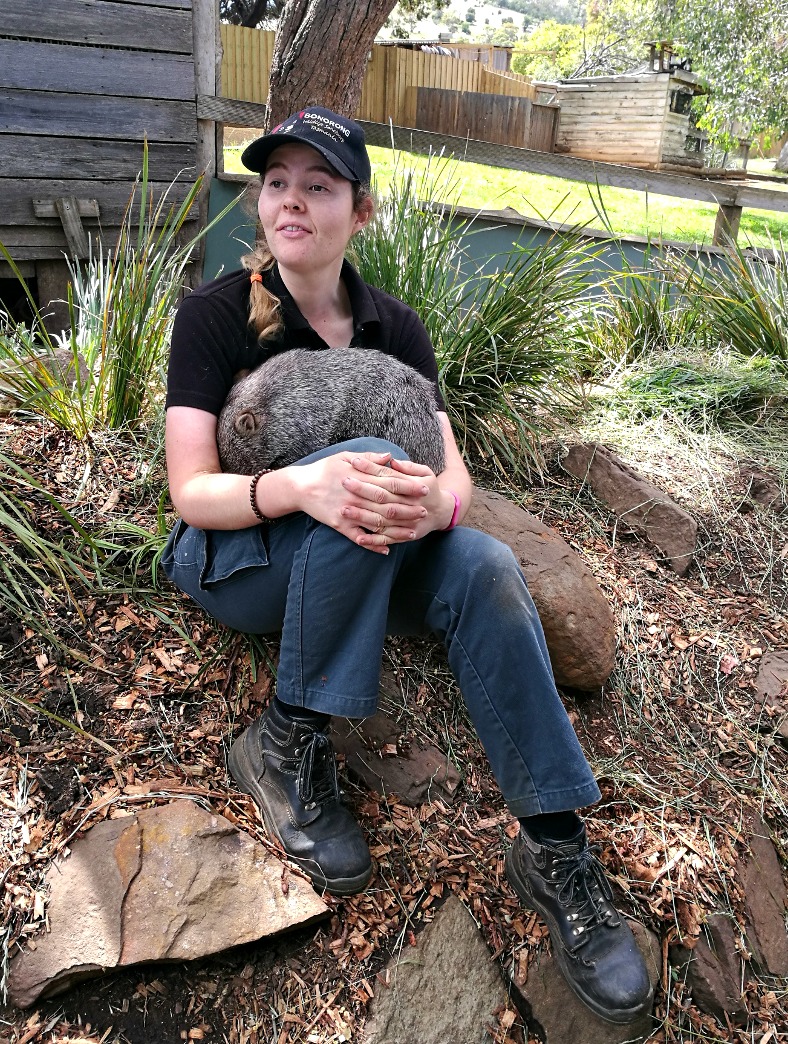
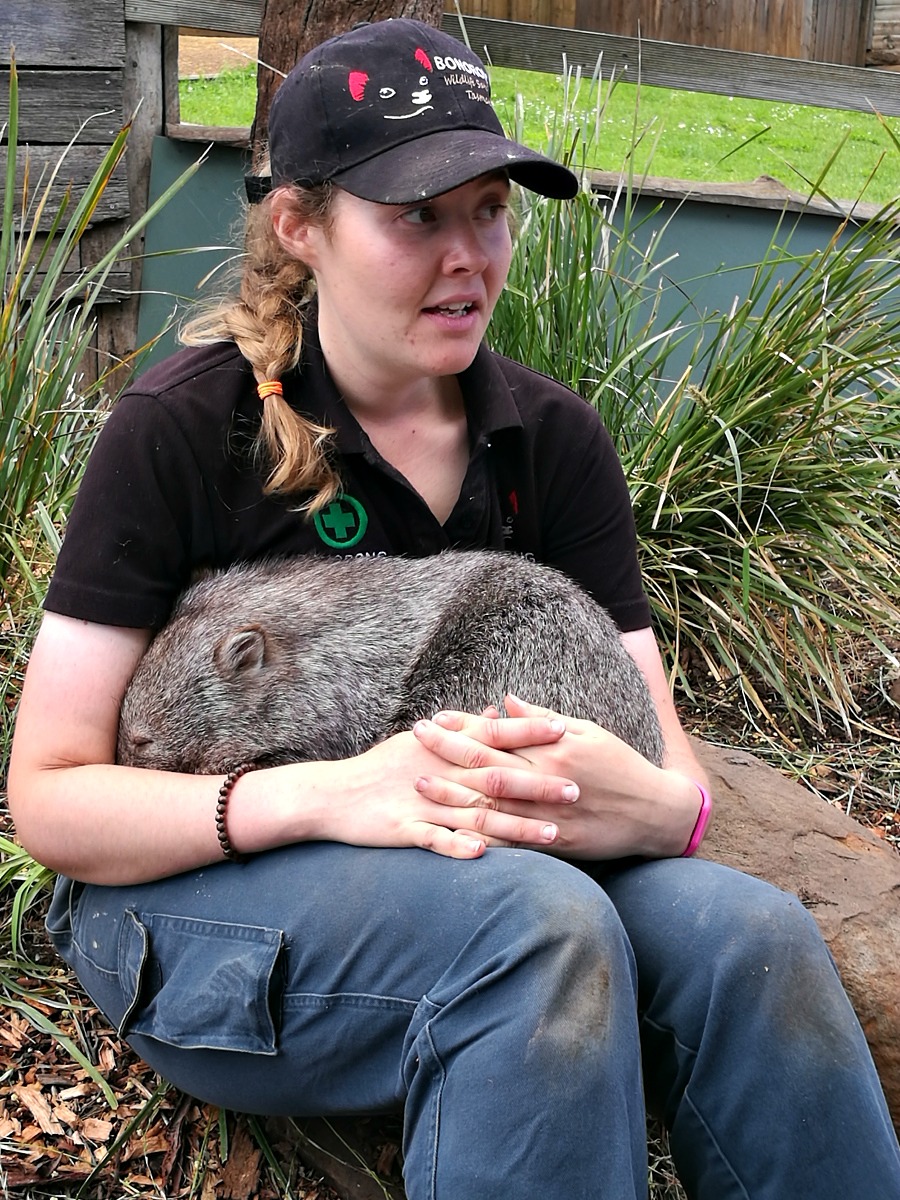
The purpose of the sanctuary is to look after Tasmania’s animals as well as educate visitors about the native animals and problems surrounding the local environment. They provide medical care to injured wildlife and re-introduce them into the wild when possible, and permanently home native animals who are unable to fend for themselves in the wild anymore. They offer informative and interactive tours for guests and run a successful breeding program for Tasmanian Devils who are at risk of extinction – see my previous post for more info about the threats that face Tasmanian Devils.
What can you see on your visit?
There are lots of animals to be seen at Bonorong including kangaroos, wombats, koalas, Tasmanian devils, snakes, lizards and birds such as cockatoos, rosellas and emus. If you are visiting Bonorong you can join one of their daily tours (which start at 11.30am, 2.00pm and 3.30pm and run for around 45 mins) or simply wander around and explore on your own. I recommend joining one of their tours because you will find out more about their work and the animals in their care; and because you also then get the opportunity to pat a wombat and a koala!
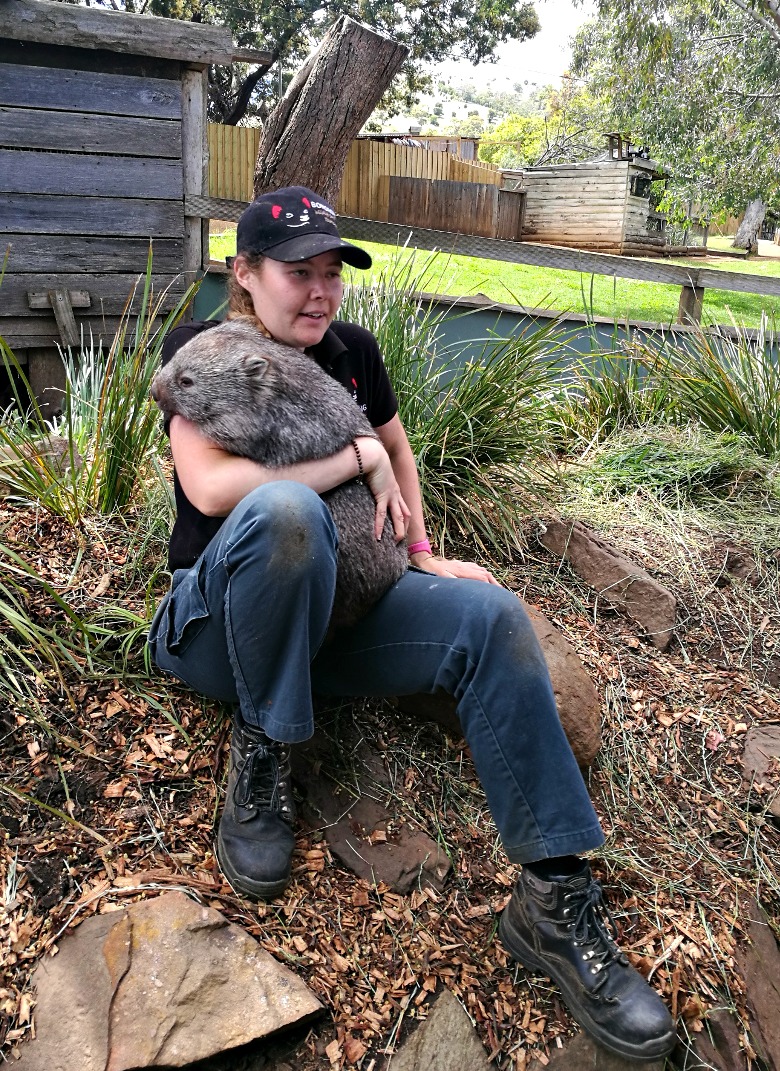
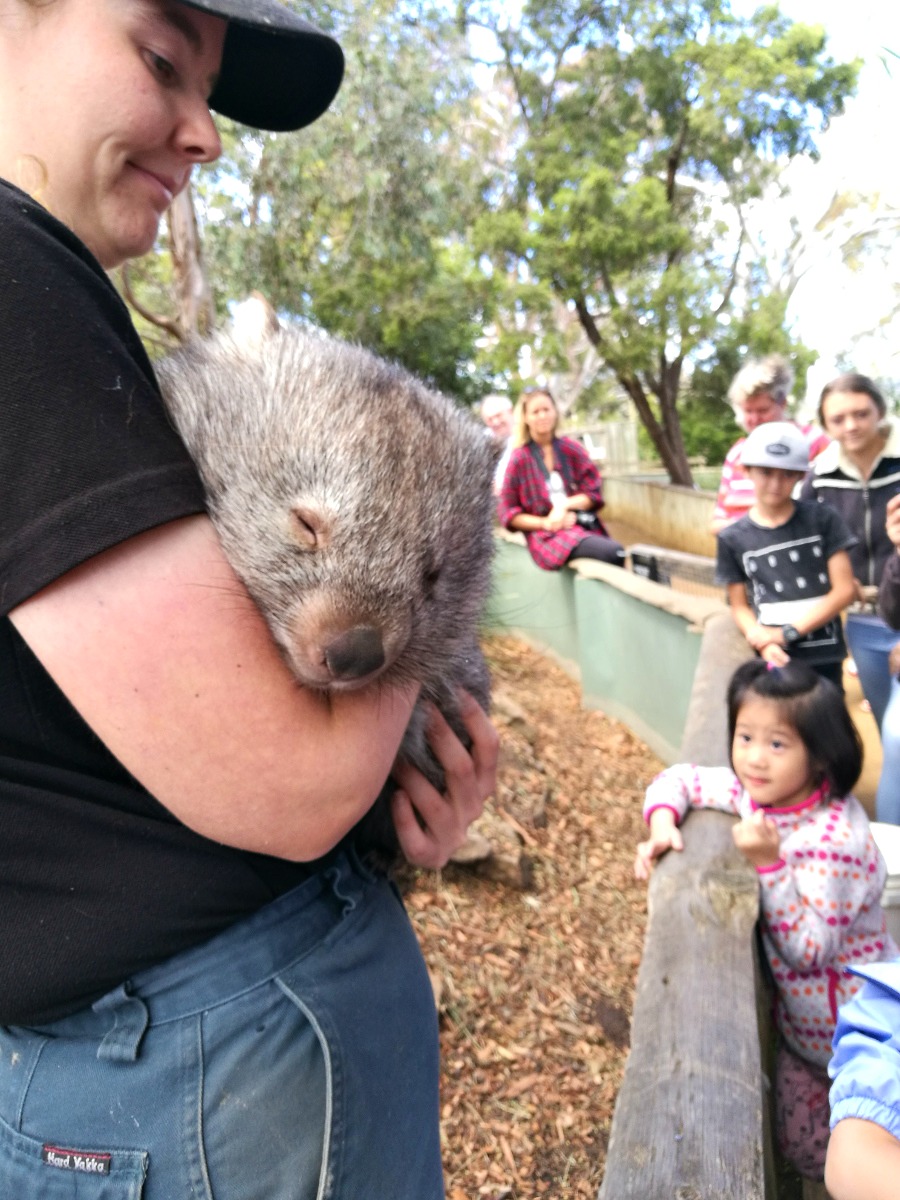
The wombat seen here is only young and will be released back into the wild when she is about two years old. She was very sweet, only wanting to sleep and snuggling up into the arms of the keeper who ran our tour. You can pat the wombat on her bony butt and I was very interested to learn that wombats have a solid plate of cartilage in their butts, which they use for protection! For example, if they are attacked by a dog or something then they run into their burrow and their solid butt is too strong to be grabbed onto or even hurt very much. Both the wombats at the sanctuary at the moment came to be there because their mothers were killed by cars, but the young can still survive inside the mother’s pouch for a while. A great reminder to always check for young if you accidentally hit any native wildlife in Tasmania.
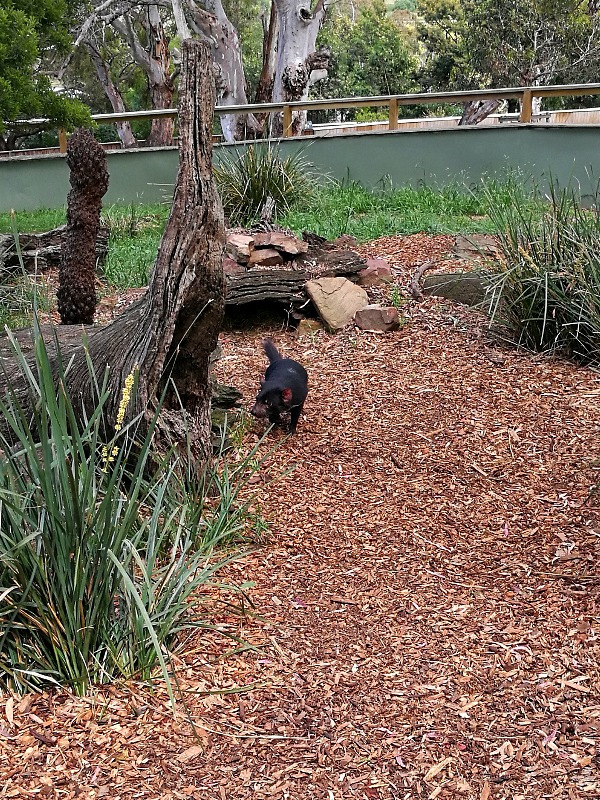
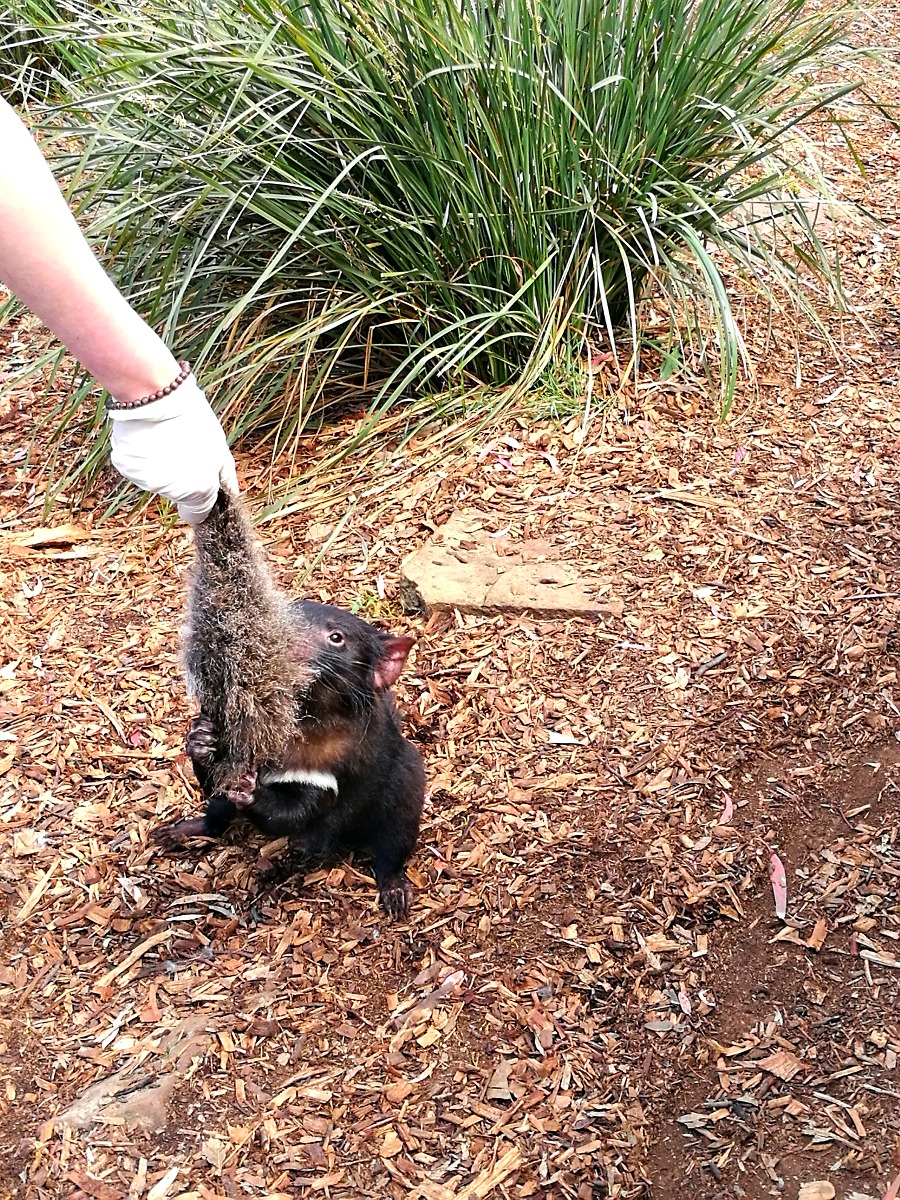
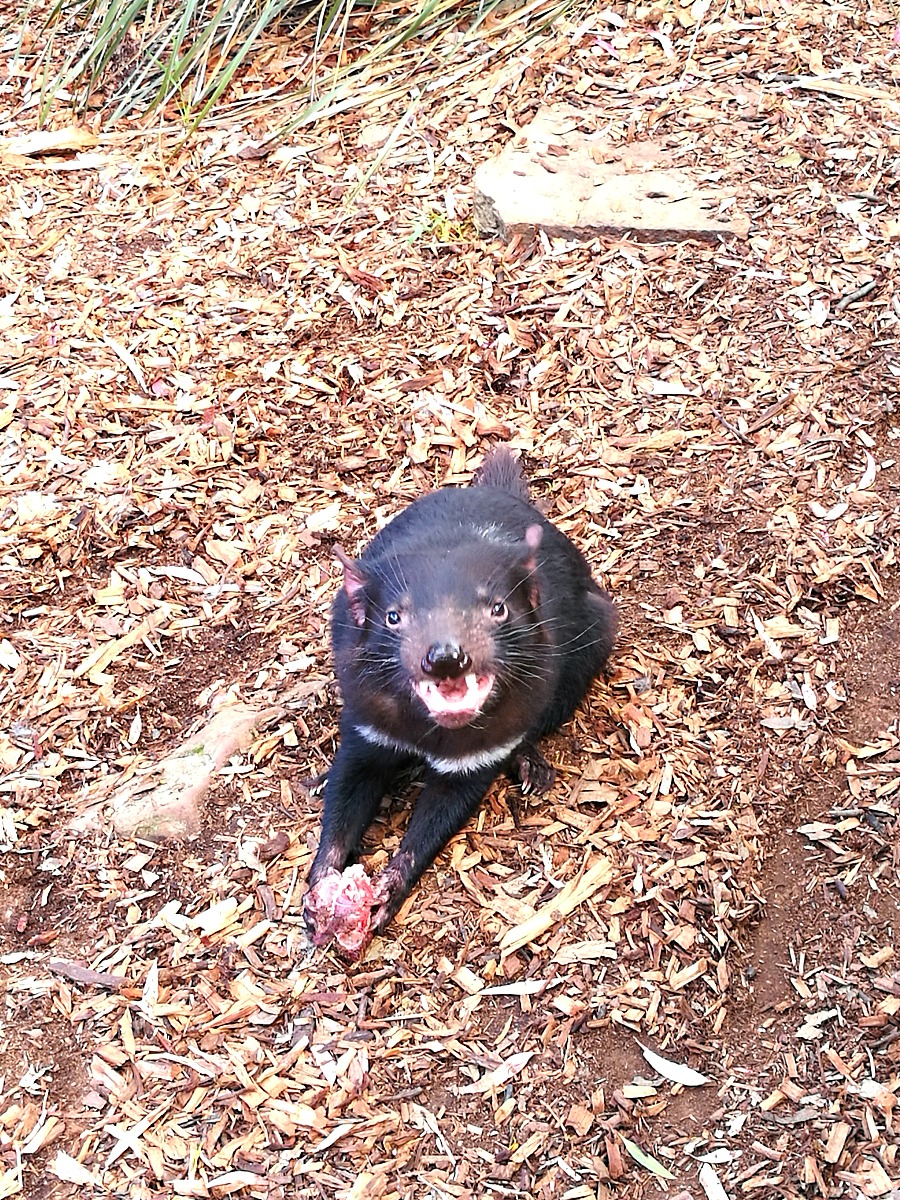
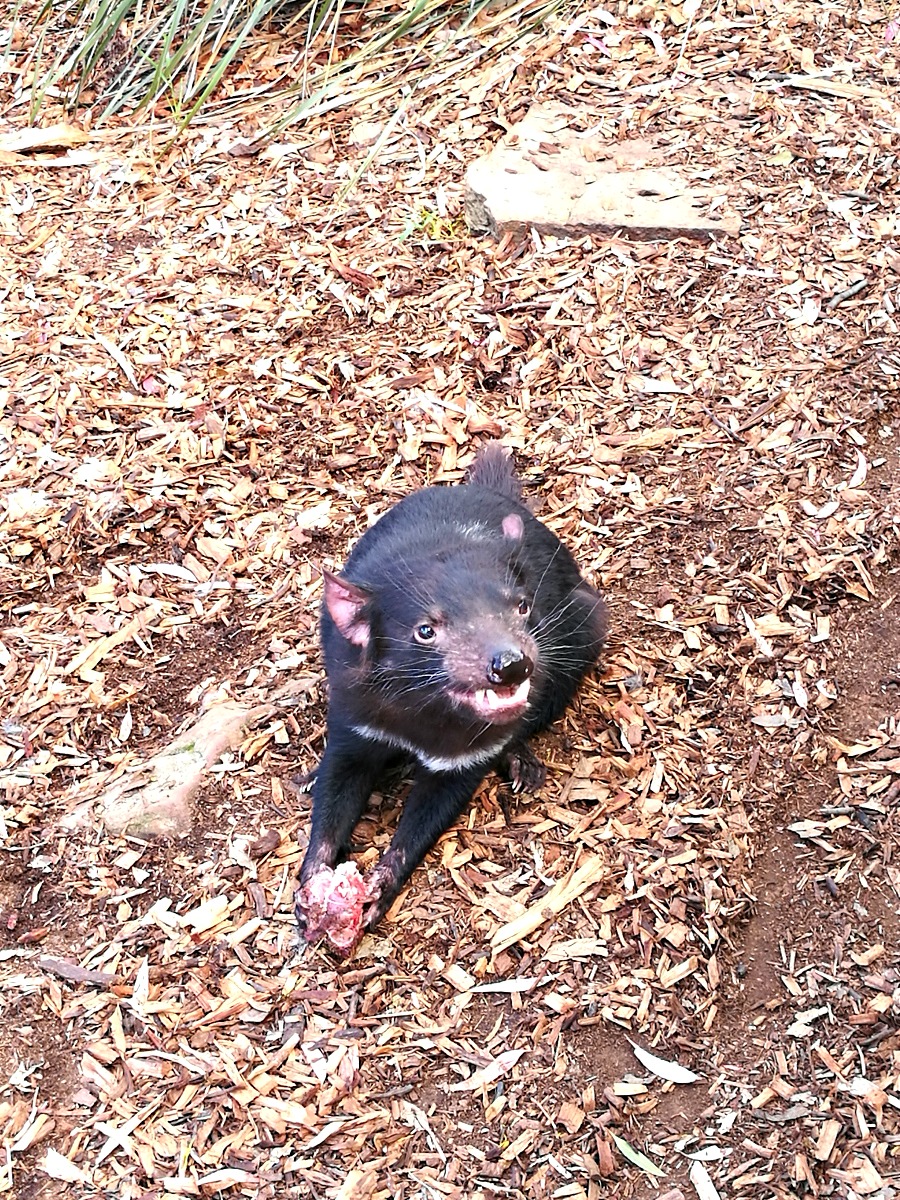
During the tour, you also can see Tasmanian Devils being fed, although only one girl ventured out from her hiding place while I was there. There are quite a few very large enclosures for the Devils at Bonorong and currently 20 Devils live there. Apparently, there were a few Devils in the enclosure where we saw the little girl being fed, but in some of the other enclosures only one Devil was housed, probably to prevent fighting. I was very interested to see the sort of ‘bungee cords’ they have installed in these Devil enclosures, they attach meat to this so that the Devils can still rip and tear meat apart the way they generally would with other Devils.
In the above photo, you can see the bungee rope hanging above this very lazy male Devil! Every time I saw him he was sprawled out sunbathing, he was quite funny to watch!
During the tour we also got to see some Koalas being fed, which is rather rare for Tasmania as Koalas don’t live here in the wild. Since Koalas sleep for around 20 hours a day generally the only time you will see them awake is if they are eating. They only eat Eucalyptus leaves and they are fed during the tour so that they won’t be too stressed out when people are taking lots of photos. Like the wombat, they have bony butts but this is to make it comfortable to do nothing but sit in one spot all day, not protection!
They’re also very cute and funny when they’re sleeping and even seem to be able to sleep while hanging on to the branches in weird positions!
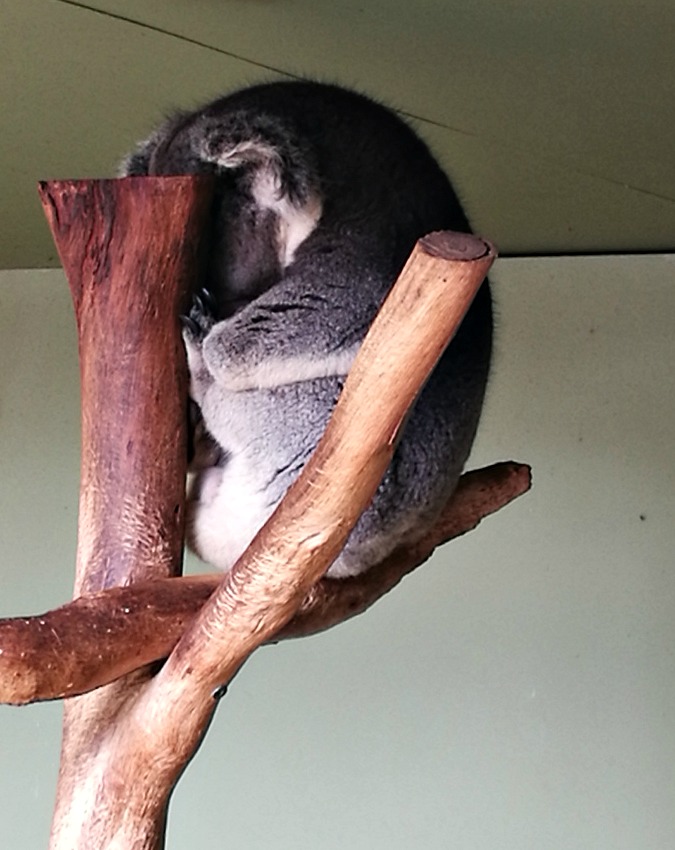
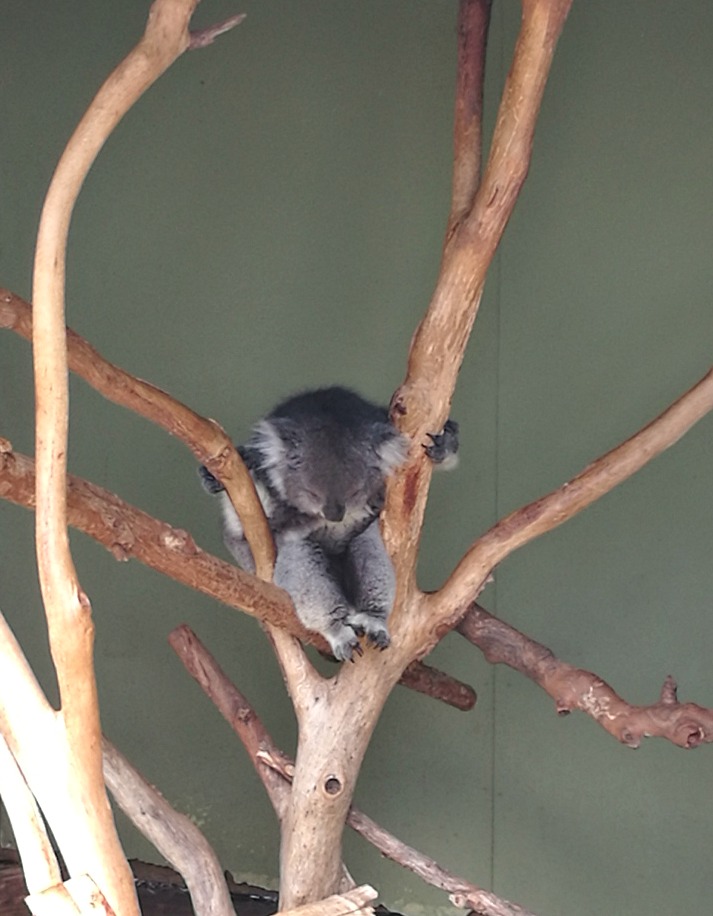
Other Wildlife
After the tour, I spent some time wandering around the sanctuary visiting other animals and birds. There are Tawny Frogmouths, Eastern Rosellas, Pink and Grey Galahs, Emus, Major Mitchell Cockatoos and Yellow-Tailed Black Cockatoos to see, as well as a beautiful male Peacock who was wandering around outside the enclosures.
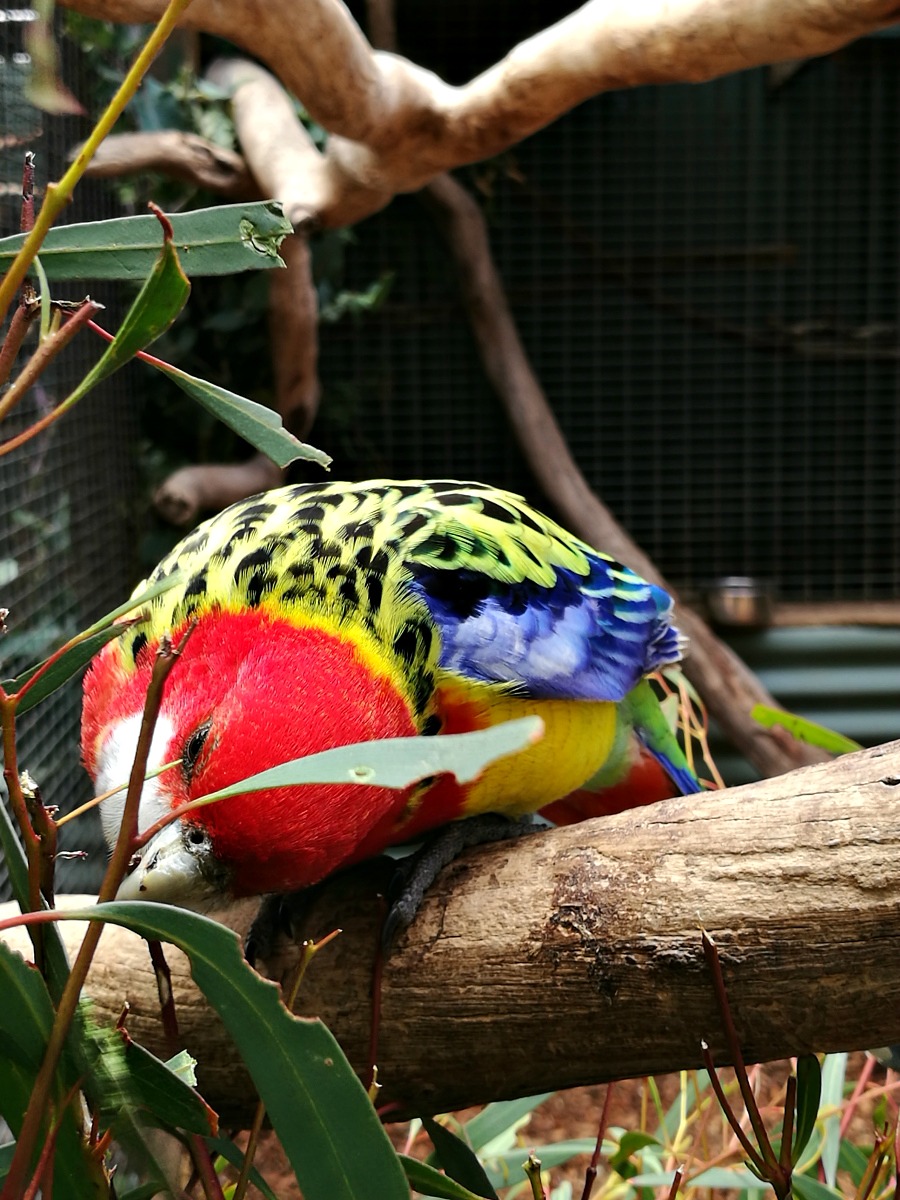
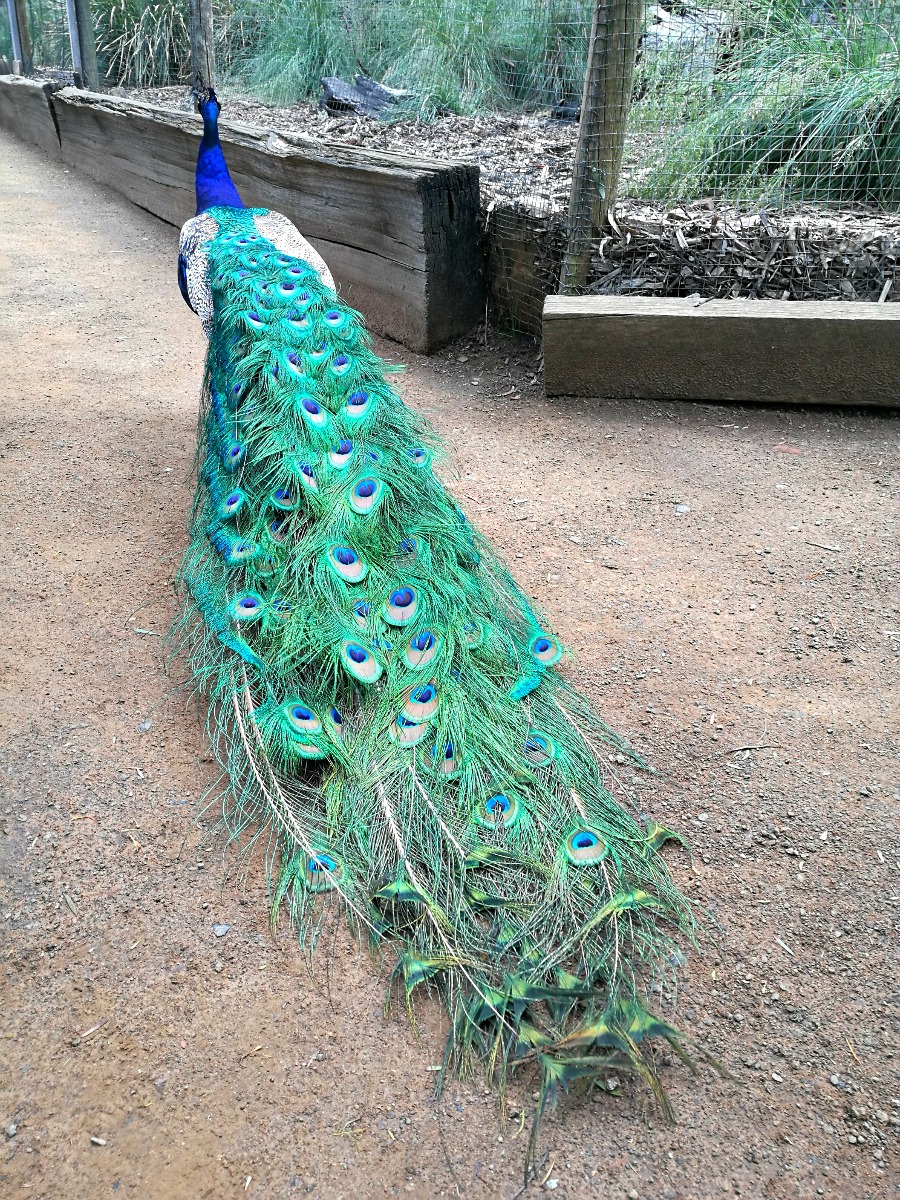
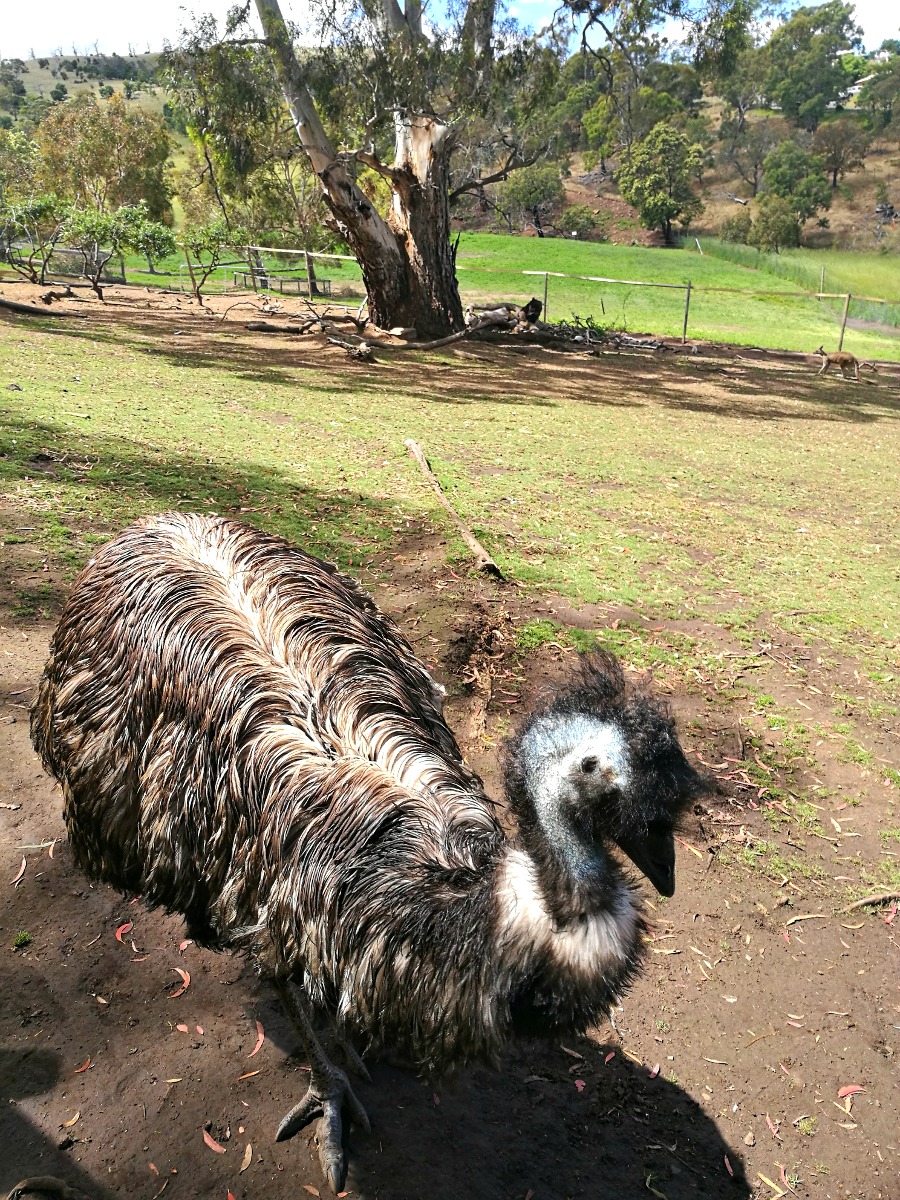
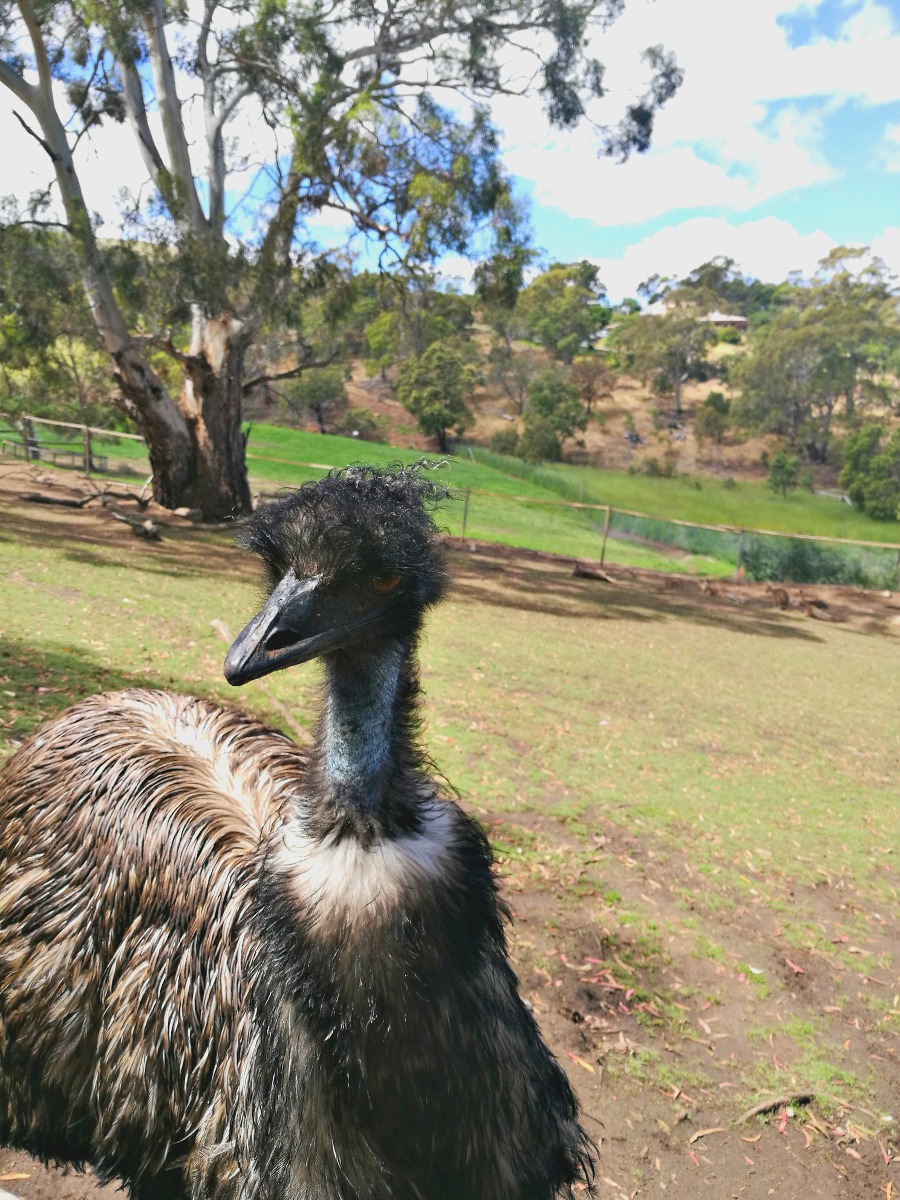
The Major Mitchell Cockatoo was called Fred and is over 100 years old! He was a pet who came to Bonorong after his owner died and sometimes says “Hello Fred” or “Hello Cocky”, although mostly only once you start walking away.
A couple of the animals are permanent residents like Fred, because they can no longer survive in the wild. The albino possum and an Echidna called Randall are both permanent residents because of this.
Poor little Randall the Echidna was attacked by a dog and had to have his right front leg amputated. Without that leg, he can’t dig properly or protect himself from predators so that’s why he now lives at Bonorong. I love Echidnas and see them often around Orford. My grandparents often have them wandering around their garden and they’re such cute little things!
Echidnas are not like porcupines in that their spikes don’t get stuck in you if you touch them, but obviously, they use them for protection and whenever an Echidna feels threatened they sort of hunch right down into the ground so only their spikes are showing. The photo on the left below shows where he’s missing a foot. 🙁
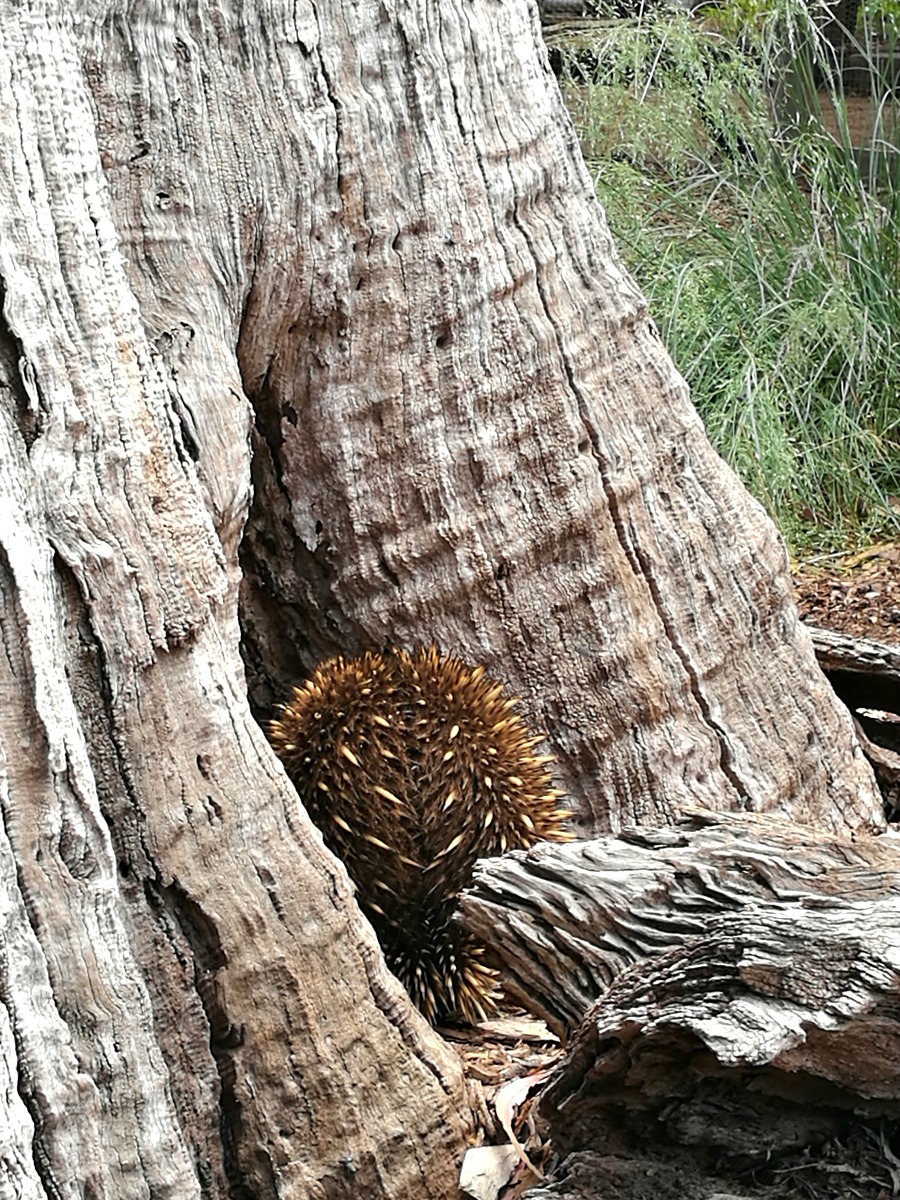
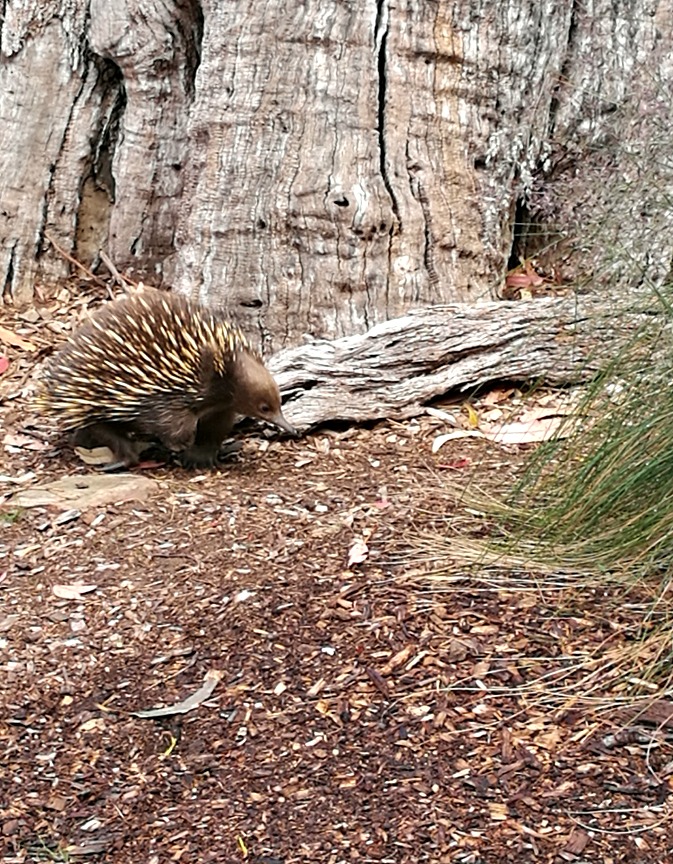
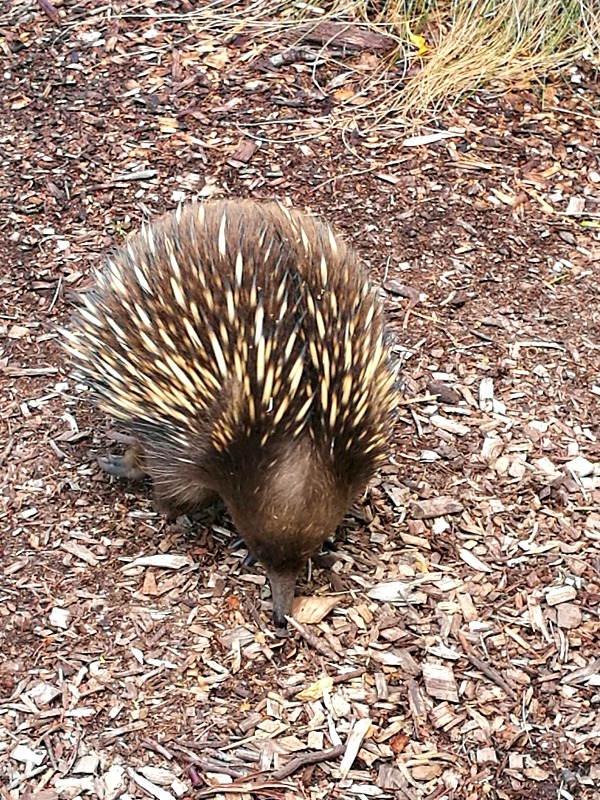
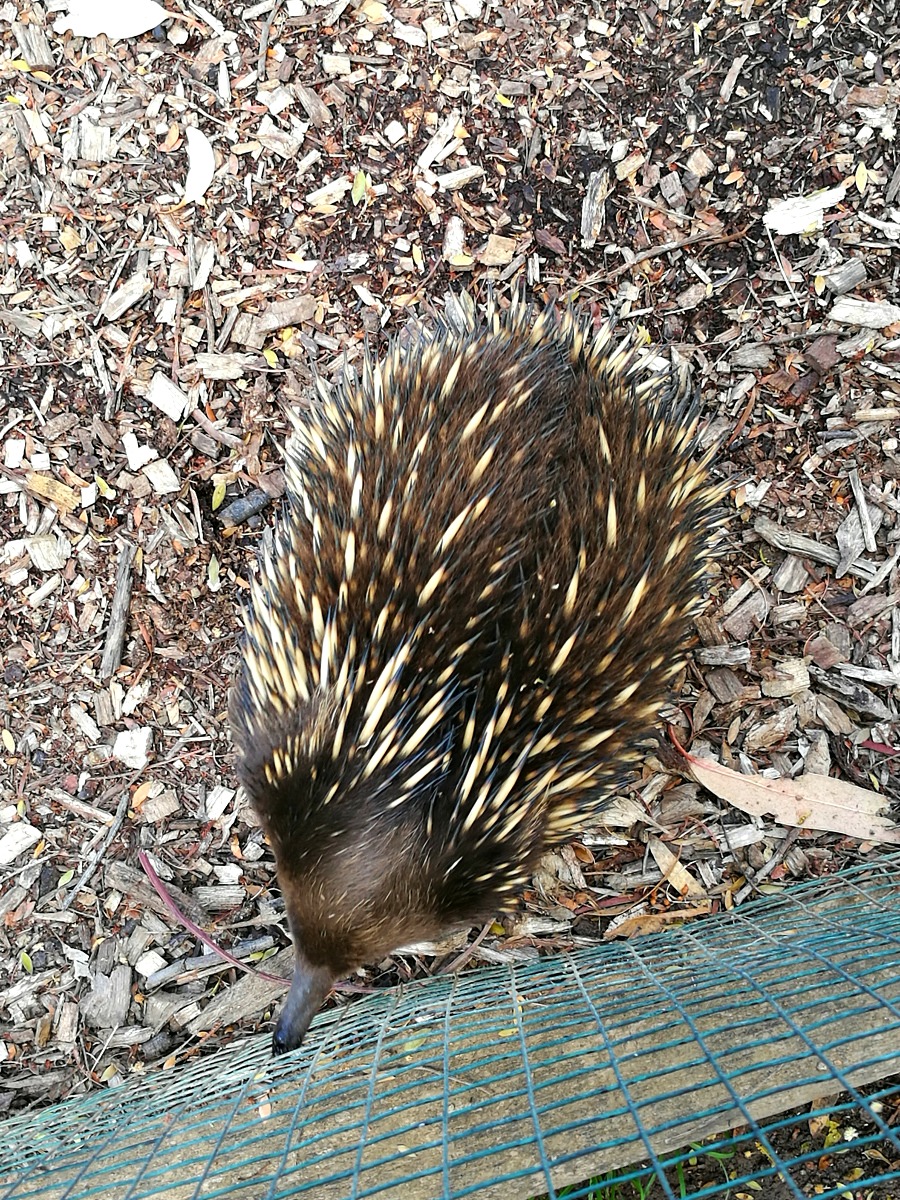
You could also see some reptiles such as Blue Tongue Lizards and snakes like the Tiger Snake. Just remember, a Blue Tongue Lizard isn’t poisonous (but might latch on to your hand if you poke it) but if you ever see a snake in the wild in Tasmania (or anywhere in Australia) keep your distance! I’m really not a fan of snakes but I don’t mind looking at them from safely on the other side of a fence.
Of course, the one animal that you will see the most of at Bonorong, are the kangaroos! There are lots of Eastern Grey/Forester Kangaroos all around the place, and they’re quite tame and relaxed around humans. When you enter Bonorong they give you a little bag of pellets to feed them and the kangaroos love that! You can get very close to them, pat them and even take selfies with them so long as you don’t move too suddenly. This one below had a ‘milk moustache’ (from water, not milk) and even stuck his tongue out at me!
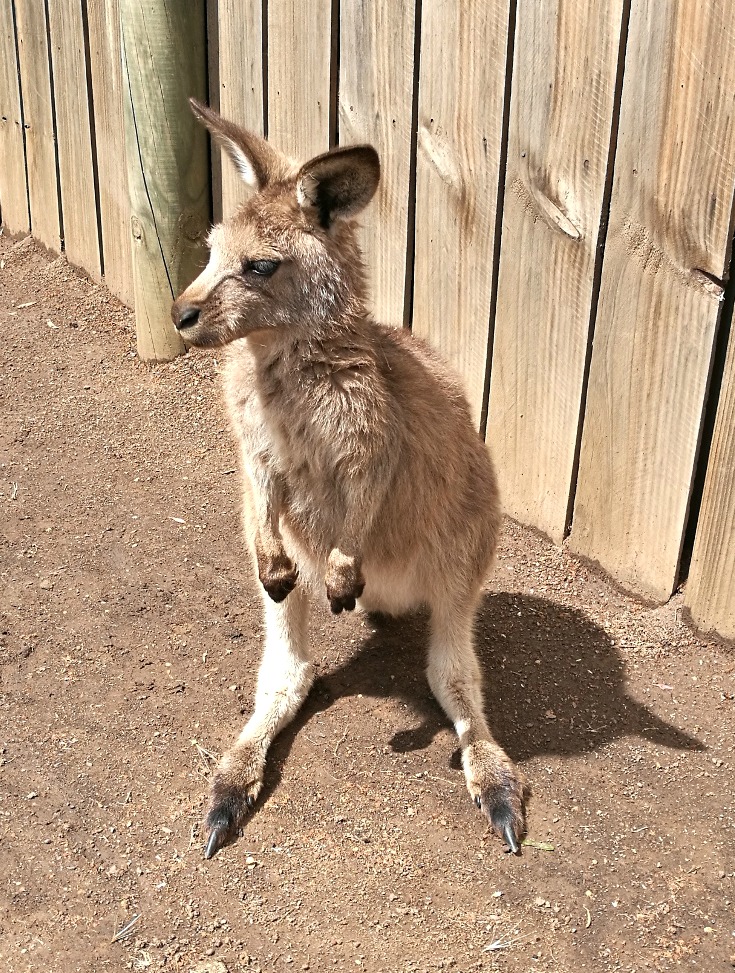
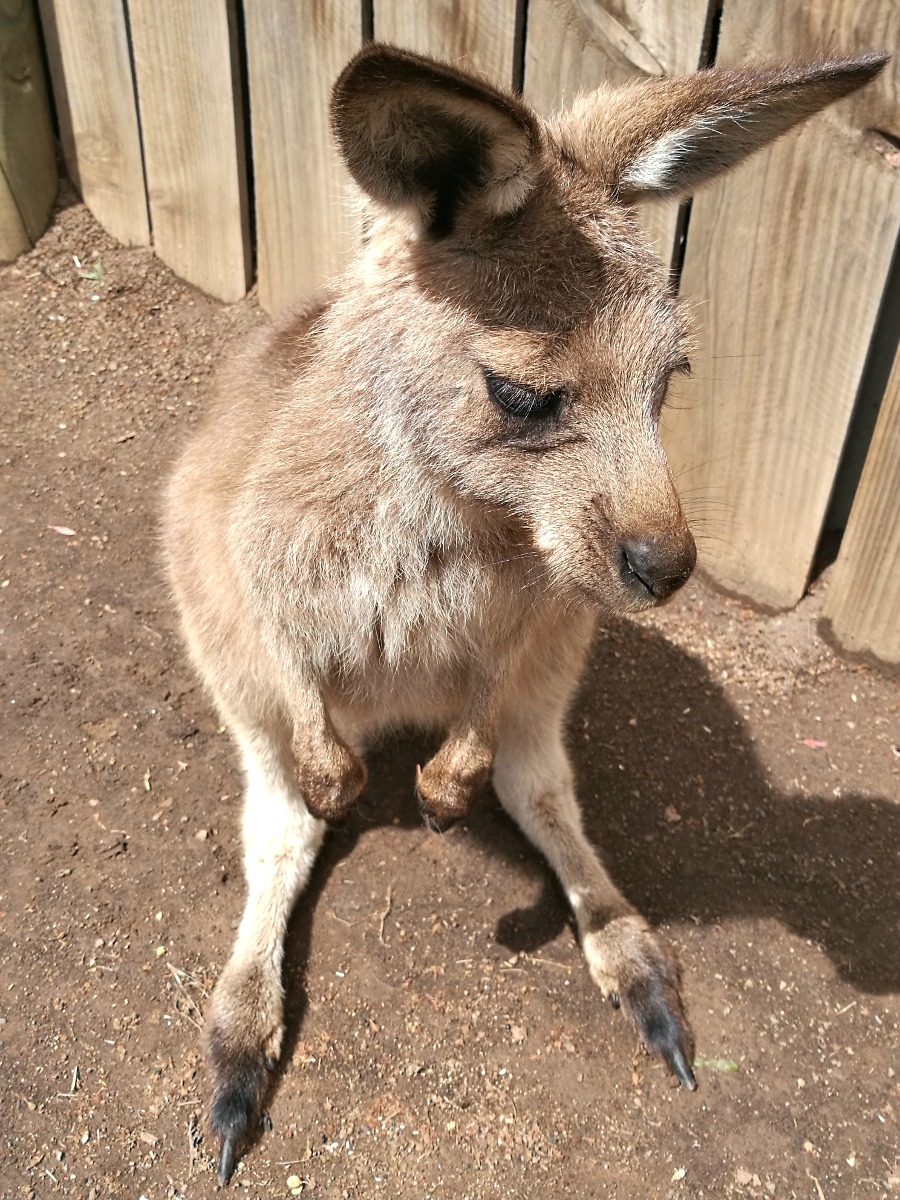
There were lots of cute young kangaroos that didn’t look like they had been out of the pouch for very long, although I didn’t see any mothers with joeys in pouches. This little cutie below was holding the hand of the lady feeding her!
Another one here looked like it was holding on to its mother’s tail for reassurance!
As I mentioned, there is a big open area in the middle of the sanctuary where the kangaroos are free to roam. You can find them all over the place, lying down, hopping around, getting a feed from the visitors or drinking from ponds. I even got some selfies with them and these lovely photos of two drinking from a small pond.
The only thing that might be a drawback for visitors to Bonorong is that it’s not really accessible for anyone who might have trouble getting around or is in a wheelchair for example. The site is on a rather steep slope and the walking trails are quite rocky and were slippery while I was there. So for someone with limited mobility, on crutches or in a wheelchair, a different sanctuary or wildlife park might be better to visit. However, if you are capable of walking up and down a steep hill then this is a great place for a visit. There are areas for picnics and barbecues and even some comfy couches under a porch.
Getting to Bonorong
If you have access to a car then it takes about half an hour to drive to Bonorong from Hobart. It’s also located about a 20-minute drive from Richmond, which is also well worth visiting, so you can easily combine both places in one day. Get your tickets for Bonorong ahead of time here.
If you won’t have access to a car then you can join a guided half-day tour of Bonorong from Hobart, or you might like this full-day tour that takes you to some sights in Hobart before visiting both Richmond and Bonorong as well. Since many of the animals at Bonorong are nocturnal, you can even join a guided night tour to ensure you see the animals when they are active, and hand-feed some of them!
Make sure you check out their website if you are planning a visit for all the details on opening times, prices, tours and private animal encounters!
Have you ever been to Bonorong? What is your favourite native Tasmanian animal? Let me know in the comments and don’t forget to sign up for your guide on where to see Tassie Devils in Tasmania below! Until next time 🙂
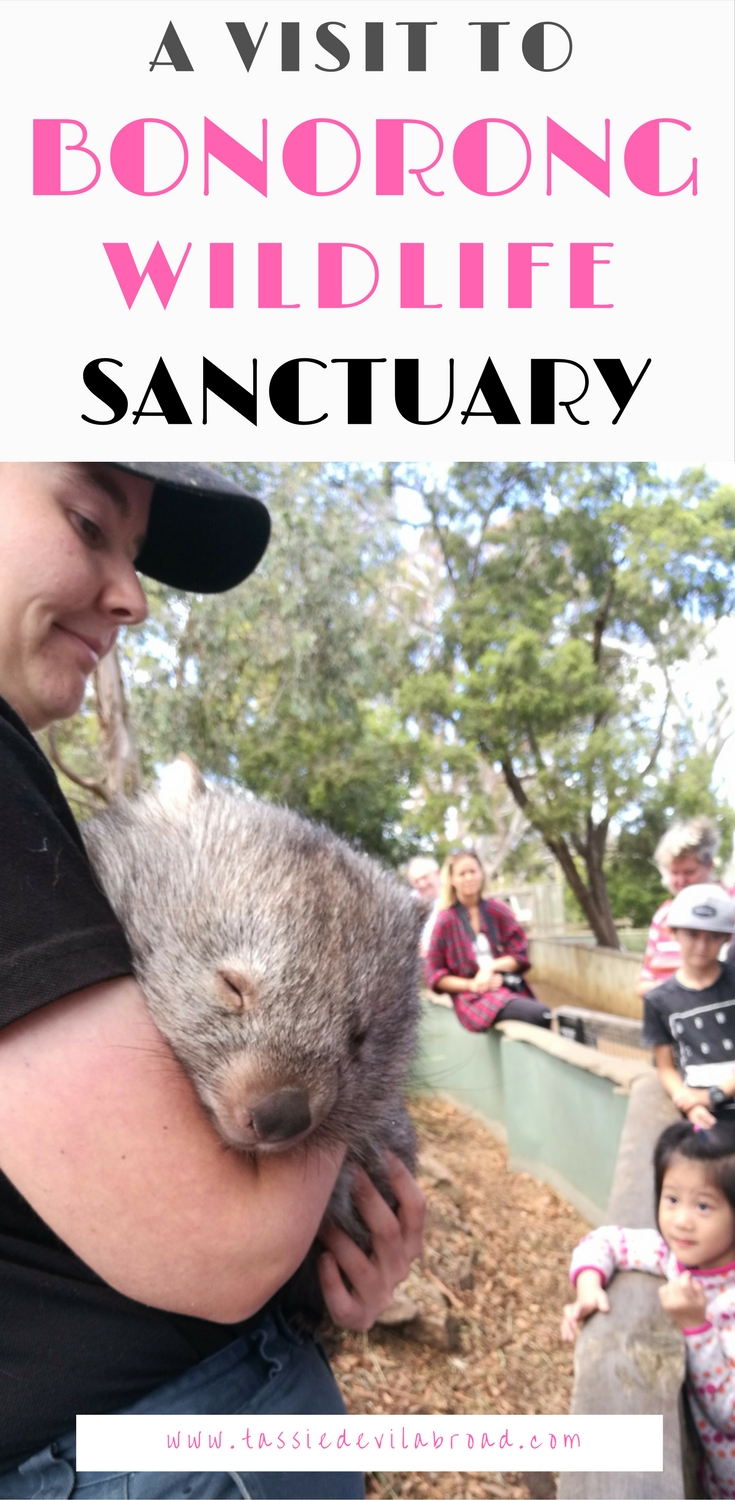
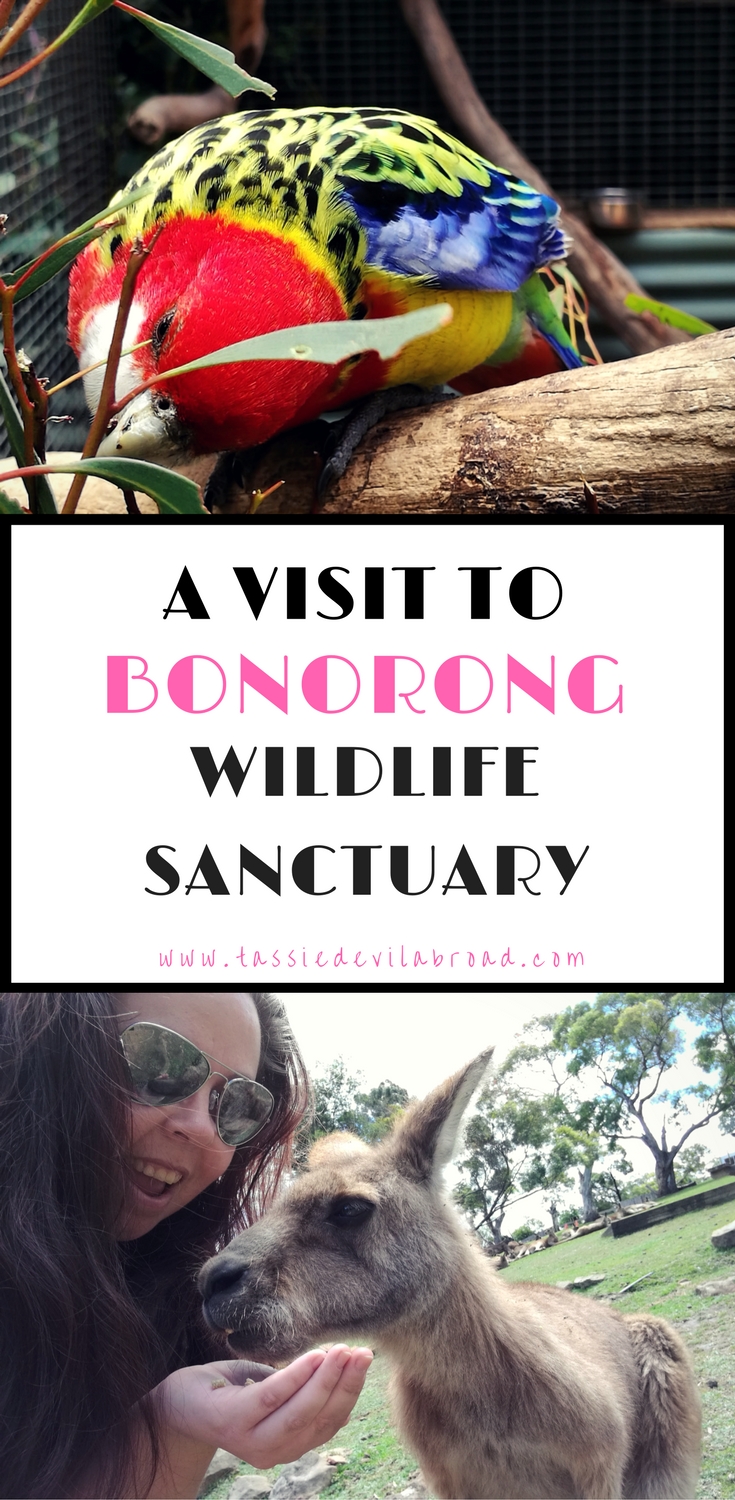
Disclaimer
All information is true and correct at the time of publishing but I cannot be held responsible for changes in opening times and prices or businesses closing in the meantime. I always endeavour to keep my posts up to date but also encourage you to double-check the official website of an attraction for information on when it is open, how much it costs etc.
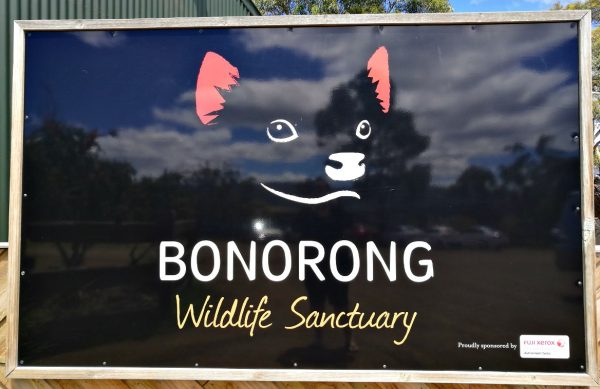
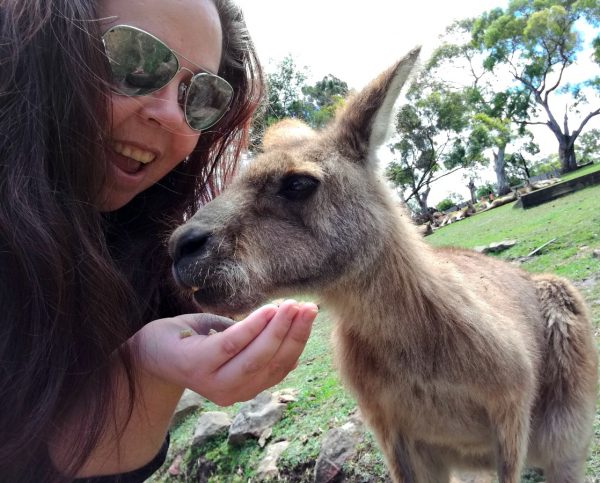
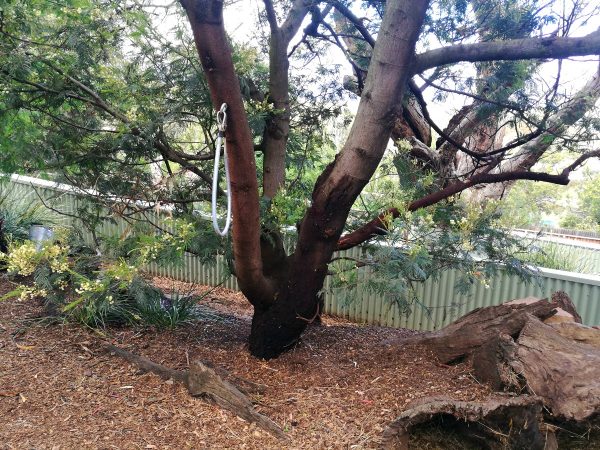
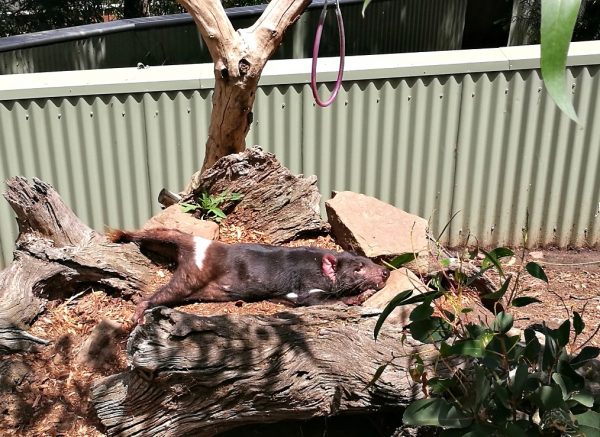
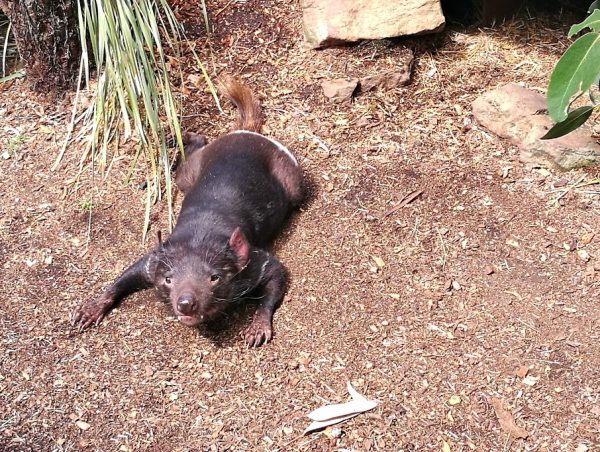
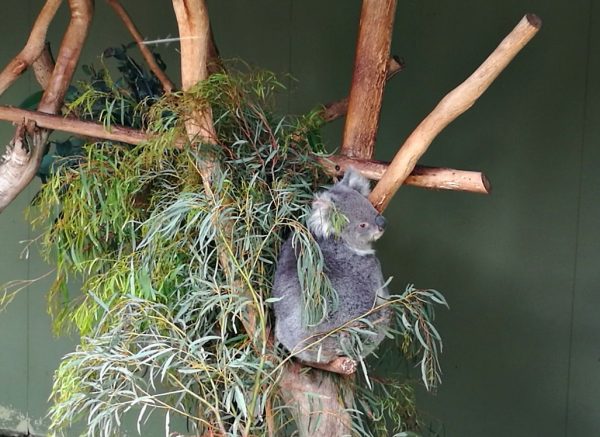
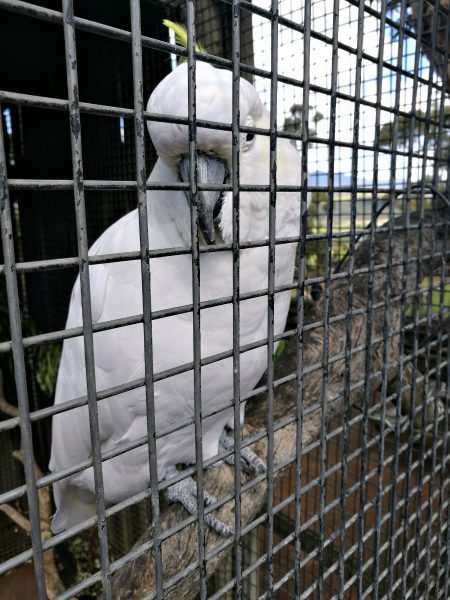
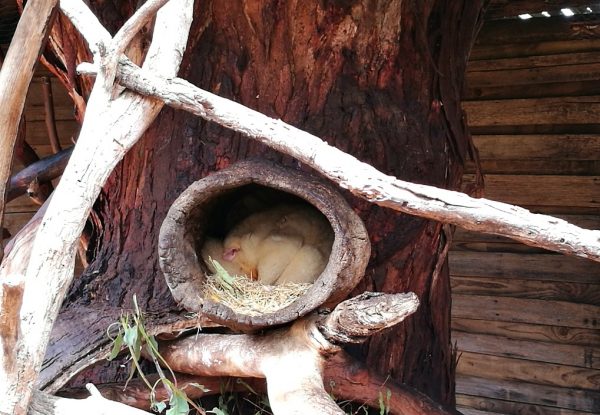
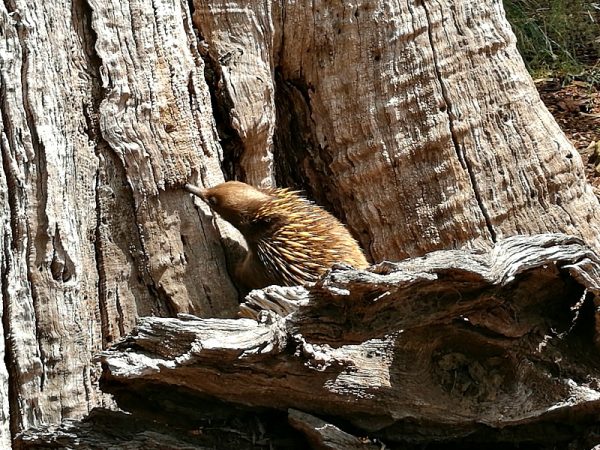
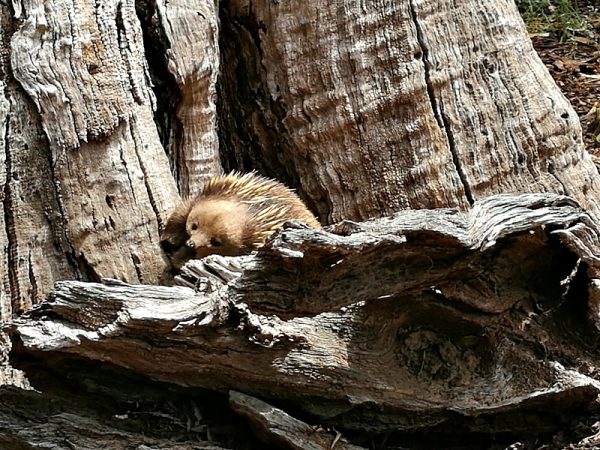
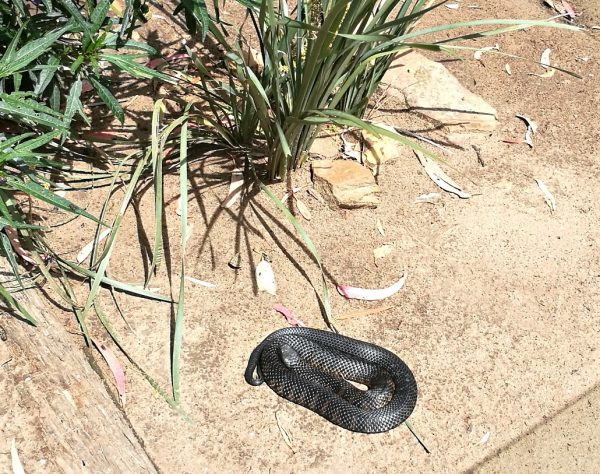
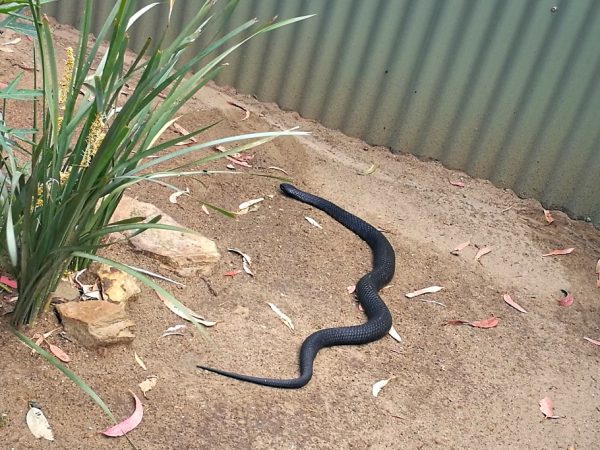
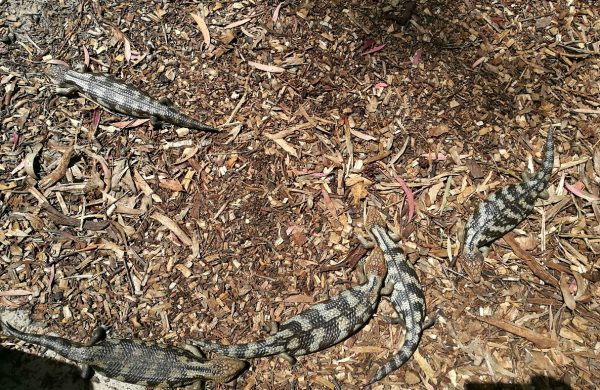
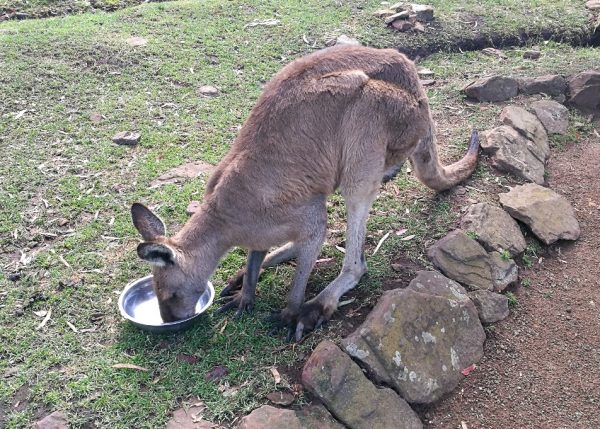
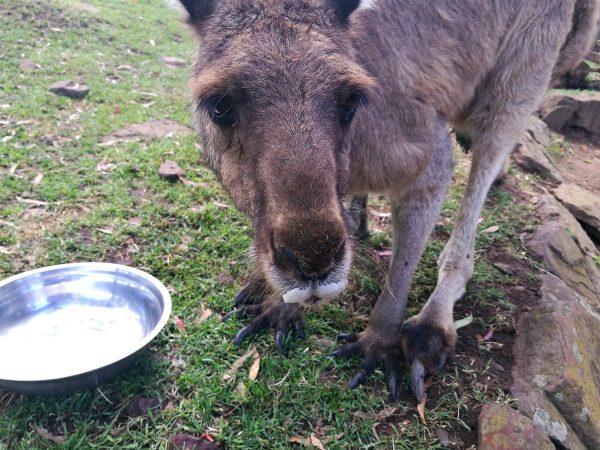
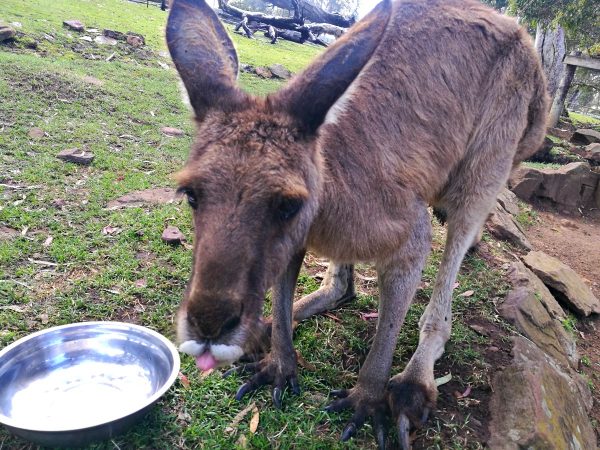
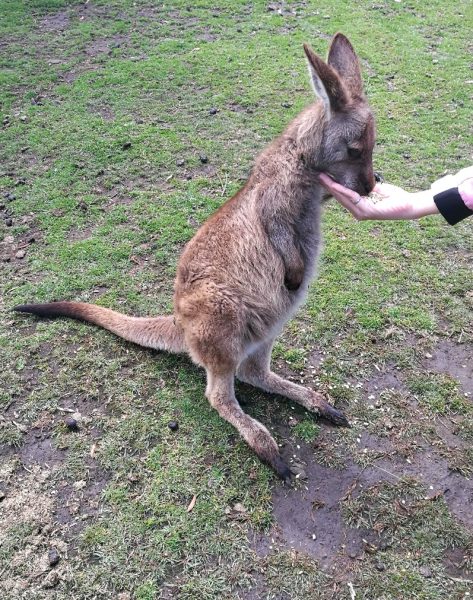
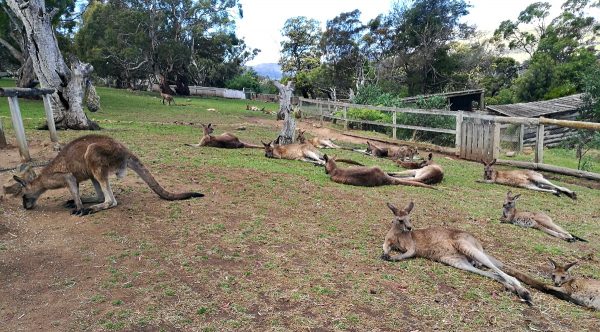
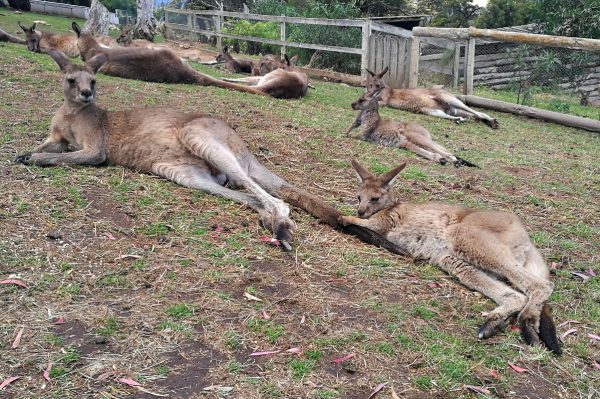
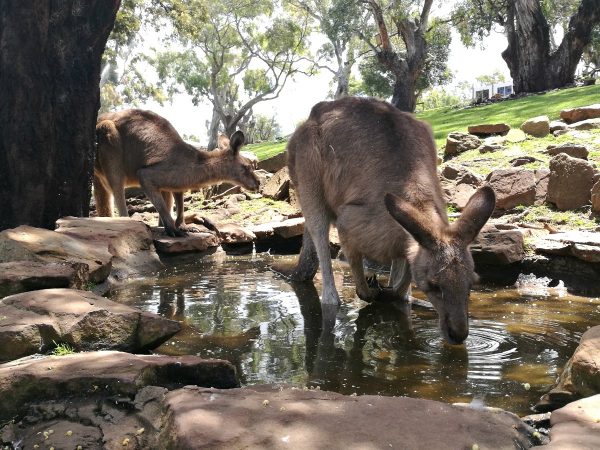
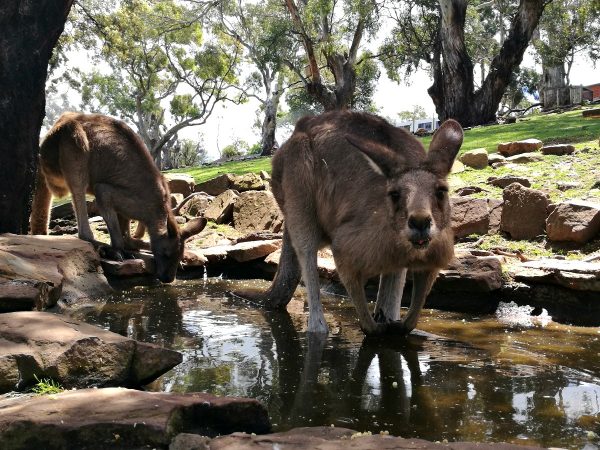
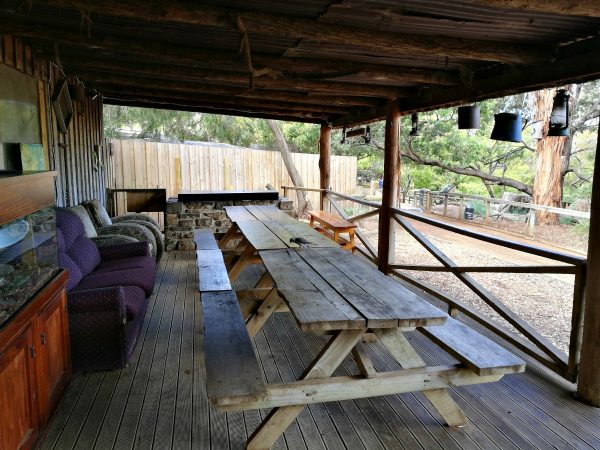
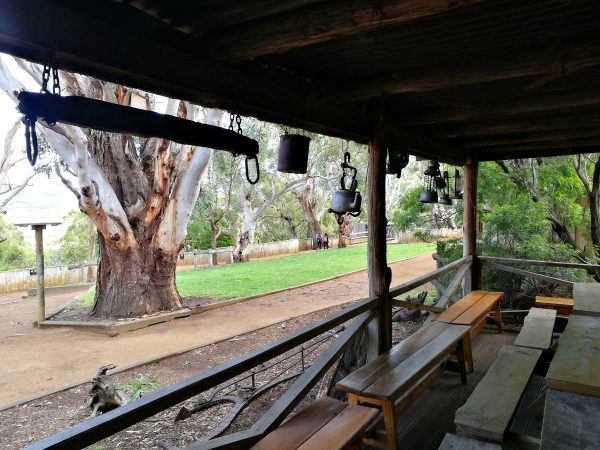
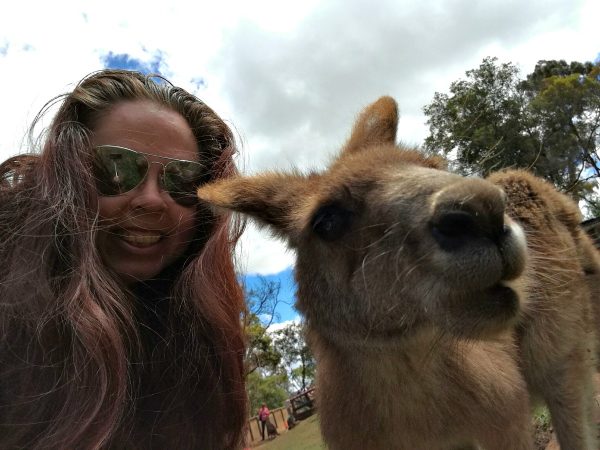
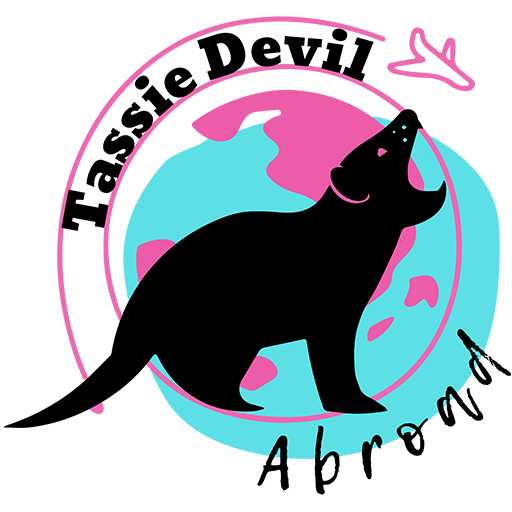
[…] in 2014 at the Bonorong Wildlife Sanctuary. While this was the last official news of Fred, he appears to still be alive based on reports and pictures from people who recently visited Bonorong. According to Bonorong, […]